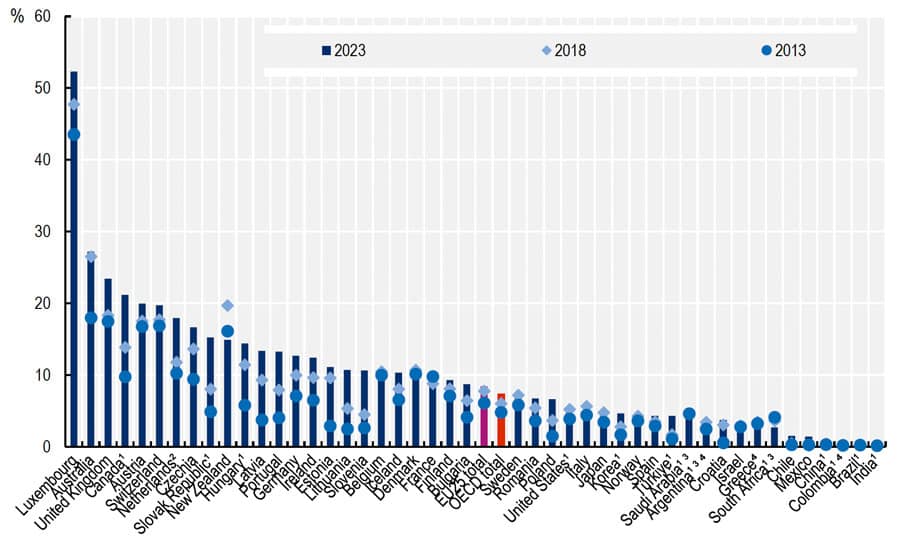OECD tracks global student flows to developed market-based economies
- A new in-depth report tracks tertiary attainment and student mobility across the 38 member countries of the Organisation for Economic Co-operation and Development
- It finds that the proportion of international enrolment, as compared to total tertiary enrolment in a given country, has gone up over the last ten years for most OECD member countries
- OECD states, and especially the Big Four destinations of the US, UK, Australia, and Canada, host most of the world’s internationally mobile students
- However, student flows are becoming more affected by increasing competition among destinations and policy interventions by national governments
The OECD (Organisation for Economic Co-operation and Development) is an inter-governmental organisation made up of 38 member countries. Collectively, the member states have a population of 1.38 billion (about 17% of the world's total), but they account for nearly half of global GDP. This is, in short, a group of the world's advanced, market-based economies.
And, it turns out, OECD countries are also hosts to the lion's share of the world's internationally mobile students.
The OECD has just released the 2025 of its annual Education at a Glance report. The report provides an in-depth look at educational attainment and other key indicators and trends across the OECD countries.
This year's report points out that, out of the more than 6 million students abroad in higher education in 2023, just over 5 million were enrolled in OECD countries. And of those, nearly half (46%) were studying in the United States, the United Kingdom, Australia, and Canada.
However, as the scale and capacity of higher education systems vary so widely across OECD countries, those absolute enrolment numbers don't tell the whole tale. Part of what makes Education at a Glance interesting reading every year is that the authors are very thorough about examining different aspects of tertiary enrolment and attainment. As we see in the following chart, for example, the proportion of foreign students – in relation to total tertiary enrolment in a given OECD country – ranges quite a bit.
Foreign students account for more than half of all tertiary enrolments in Luxembourg, for instance, but only 5% in the United States (where there were nearly 1 million students in 2023). The average across all OECD states is roughly 7%. What we can observe in the chart otherwise is that, for many OECD countries, the proportion of foreign enrolment in their respective tertiary systems has increased between 2013 and 2023.

Global flows by region
Not surprisingly, students from Asia make up the largest group of internationally mobile students, accounting for 58% of all foreign tertiary enrolments in OECD countries as of 2023. Europe is the next-largest sending region with European student making up one in five (19%) enrolments as of 2023. However, the OECD notes, "Many European students stay within Europe, accounting for 39% of mobile students enrolled in the EU25 countries."
Within Africa, South Africa is the largest host of foreign students, but, shades of Europe, most (86%) of its students come from elsewhere on the continent. That regional student flow is quite strong in Latin Americas as well, with students from across LatAm making up the majority of internationally mobile students in Argentina, Brazil, Chile, and Colombia.
Policy settings intrude
This year's Education at a Glance notes that policy settings in destination countries have begun to influence student flows more significantly, both positively and negatively. "Many countries have initiatives to promote themselves as study destinations," says the report. "Several countries set target numbers for international students they want to attract…In contrast, a few countries have started to limit the numbers of international students."
We can only imagine that when the OECD weighs out the student enrolment data for 2024 and 2025 that the impact of those policy changes will have only become more apparent and significant.
Measuring concentration of enrolment
For the first time this year, the OECD has introduced a new indicator which aims to illustrate the extent to which foreign enrolment in a given country is concentrated within a relatively small number of institutions, or whether those student numbers are more evenly distributed.
The report explains the methodology behind this new indicator: "The concentration of international mobile student indicator identifies the institutions within a country that both represent 10% of the country’s total tertiary enrolment as well as have the greatest shares of mobile students at the institutional level. It then calculates the share of the country’s international mobile students that are enrolled in these institutions. The 10% national enrolment threshold serves as a benchmark: if mobile students were evenly distributed across institutions in proportion to their enrolment sizes — with larger institutions hosting more international students and smaller ones fewer, the indicator would be exactly 10%. Conversely, if all the mobile students of a country were in the selected institutions, the value would be 100%."
The intent is to illustrate how mobile students are distributed across a country's higher education system as a whole, and we see the first reporting of this indicator for selected OECD countries in the figure below.

The report says of this year's findings for this new indicator: "Spain shows the highest concentration level, suggesting that international students are clustered in a relatively small number of institutions. In contrast, Czechia displays lower levels of concentration, pointing to a more even distribution of international students across their higher education systems. Notably, countries with very high shares of mobile students, such as Austria, Australia, Canada and the United Kingdom, also exhibit low levels of concentration among their mobile student populations. This pattern may indicate that a more even distribution of international students across tertiary institutions could be associated with the overall attractiveness of a country to international students."
For additional background, please see:
















